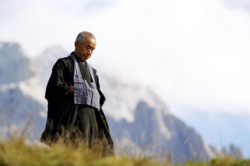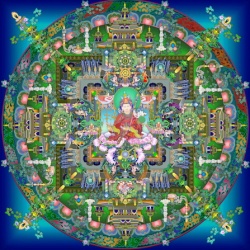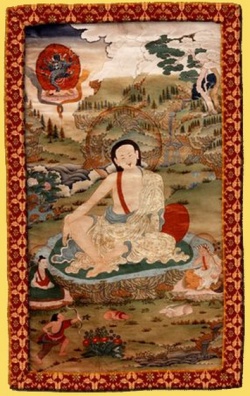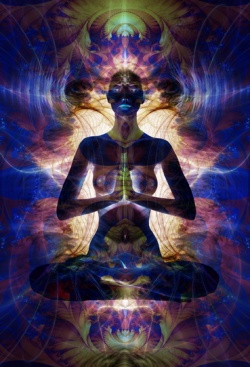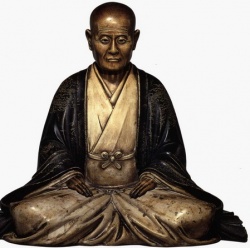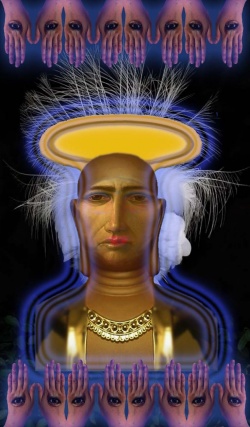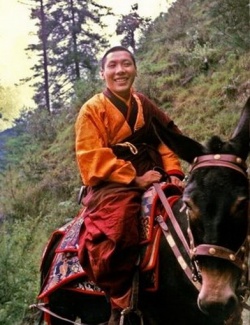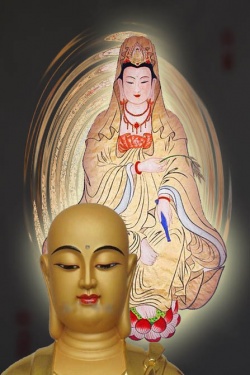Difference between revisions of "Advice on Keeping the Kalachakra Vows"
| Line 1: | Line 1: | ||
| − | <nomobile>{{DisplayImages|2419|3548|1054|958|1783|2417}}</nomobile> | + | <nomobile>{{DisplayImages|2419|3548|1054|958|1783|2417}}</nomobile><nomobile>{{DisplayImages|3957|4072|2632|4113}}</nomobile> |
Latest revision as of 13:25, 12 February 2017
The Vow Not to Lose Seminal Energy-Drops
Berzin: Many Westerners are married, what about the Kalachakra close bond of not losing (mi-nyams) seminal energy-drops (khu-ba)?
His Holiness: What lay householders should do, I don't know.
Berzin: Is this just referring to when practicing the complete stage (rdzogs-rim)?
His Holiness: What should I say? In Kalachakra, for achieving a devoid form (stong-gzugs), you need supreme unchanging bliss (mi-'gyur-ba'i bde-ba). Kalachakra speaks a great deal about the necessity for maintaining non-weakened seminal energy-drops and therefore not losing semen. That being the case, then if a person practicing the Kalachakra complete stage is a male, it would seem that it is pervasive with the person abandoning home life (rab-byung) and becoming celibate. But, I wonder if that is so? I don't know.
Berzin: For instance, Serkong Rinpoche said when you are practicing the complete stage, this is an absolute necessity. But before you reach that point, if you simply have confident belief in this and set the intention that when you reach that point you will practice like that, then it is probably OK.
His Holiness: Probably it is like that, better to explain it like that, because being able to have sexual contact without releasing semen is something needed when you practice the advanced stages of the complete stage. But to say that you are not permitted to before you reach the point of being able to dissolve into the central channel the downward-voiding energy-winds (thur-sel-gyi rlung) so that you are able to have sexual contact without releasing semen, that would be difficult, wouldn't it? To say that it is necessary for everyone who takes the initiation to act like monks would be difficult.
On the other hand, if I give the impression of telling them to go ahead and release semen, that wouldn't do at all. This is because if you really are practicing Kalachakra, you need to have no release or loss of semen whatsoever. Moreover, there is probably no division to be made in this respect between practitioners of the generation stage and of the complete stage. To state this clearly is probably better.
Now, as for the actual root downfall of discarding bodhichitta, this is talking about having the mind that wishes liberation through the bliss of orgasmic release ('dzag-bde grol-ba 'dod-kyi sems). As for this bliss of orgasmic release, some non-Buddhist traditions (mu-stegs-pa) assert that offering a homa fire puja of semen in the reality source of a woman pleases Ishvara (dBang-phyug, Shiva) and that through this one can achieve moksha, liberation. But, liberation doesn't happen like that. Therefore, specifically to stop this mistaken practice, the vow was made that if, with a mind wishing for liberation through the bliss of orgasmic release, one ejaculates one's constituent source energy-drops externally (phyi-rol-du khams-phong-ba), it is a root downfall. Usually, however, when one has and ejaculates semen, there is no thought of wishing liberation through the bliss of releasing it. Thus, it is not a root downfall.
However, there is a transgression and ignoring ( chag-'dor) of the root vow. One was not taking care about one's seminal energy-drops (khu-ba bdag-po-ma-byed). Thus, there is a transgression of the root vow, but not a complete root downfall. If one is a practitioner and one's constituent-source energy-drops are lost (khams nyams-pa yin-pa), then one weakens the generation of unchanging bliss.
Kedrub Je said that in Kalachakra, it is necessary for constituent-source energy-drops never to be lost at all. He states this in conjunction with the point concerning methods for actualizing blissful awareness. In Chakrasamvara and Guhyasamaja, one actualizes an illusory body. In Kalachakra, however, one actualizes a devoid form and a devoid form is actualized within a state of supreme unchanging blissful awareness. Because of that, it is extremely important never to degenerate, weaken, or lose one's constituent-source energy-drops, he says.
Therefore, to constitute a root downfall, one needs the mind of wishing liberation from the bliss of orgasmic release. Furthermore, although root downfalls will not occur without such a wish, still the flaw can occur of being stained with the fault of an infraction of the vow. To avoid this, one needs to safeguard against losing one's seminal energy-drops if one is a serious practitioner of Kalachakra, at any stage of the practice. Nevertheless, to say that this pertains mainly to complete stage practice and leave it at that is probably OK.
Women Not Emitting Seminal Energy-Drops
Berzin: How should women understand the vow not to emit seminal energy-drops?
His Holiness: When Kalachakra speaks of constituent-source energy-drops being emitted, they are not necessarily a gross liquid and do not necessarily have to come out of the body externally. What we need to eliminate are the propensities for these subtle energy-drops to move (g.yo-ba'i bag-chags). We have to cease ('gag, stop) all movement of the constituent-source energy-drops and bind them unmovingly.
For instance, in terms of men, not merely is it not having constituent-source energy-drops fall (lhung) outside the body with gross liquid drops of semen. In addition, when the constituent-source energy-drops cascade down (mar-babs) first through the chakras in the central energy channel as white bodhichitta, we need to make that which has fallen remain stable (brtan-par gnas). That is what unmoving means.
In other words, when the subtle constituent-source energy-drops descend in the central energy-channel through the burning of the inner heat of tummo in advanced complete stage practice, they need to stay put there. One does not put an end to the blissful awareness by having the subtle drops join with seminal fluid and move outside the body. One needs to maintain this blissful awareness to have it focus on voidness.
Not only outside, but even inside the central channel, the constituent-source energy-drops may move back up ( yar-log-pa). We must bind them so that they don't return up. This requires stacking them inside the central channel, like building a wall – stacking or piling them up one on top of the next.
This non-moving of the constituent-source energy-drops comes from relying on a devoid-form mahamudra (great sealing partner). In the stages of meditation, union with a visualized jnanamudra (deep awareness partner) causes the constituent-source energy-drops to drip down and brings moving blissful awareness (g.yo-ba'i bde-ba) since the drops move back up the central channel. Practice with a devoid-form mahamudra brings the unchanging blissful awareness of the constituent-source energy-drops not moving or shifting, either externally outside the body in connection with gross liquids or internally back up the central channel.
Berzin: So women have this vow too?
His Holiness: Yes, yes.
Berzin: Is it to be understood only on an internal level of not having their constituent-source energy-drops move in their central channels? Or, does it also refer to their worldly bliss of an orgasmic external release of constituent energy-drops?
His Holiness: I really don't know. It is difficult to say, since it is not clear in any text, but women undoubtedly have something similar. If we consider men, when constituent-source energy-drops fall outside (lhung-na), then at that point, since the basis for the blissful awareness has been lost (bde-ba'i rten nyams-pa), the blissful awareness itself ceases, doesn't it? So if men can bind (bcings, hold) the basis for the blissful awareness, the bodhichitta drops, without it being lost (nyams), the blissful awareness will not go away, will it? Women must have something analogous, whether or not it entails a release of gross fluids.
Not Belittling Women
Berzin : Concerning another of the tantric vows, not belittling women, should women think in terms of not belittling men?
His Holiness: Could that really be? Probably not. I doubt it. Among women, there are a few very special persons, such as vajra dakinis (rdo-rje mkha-'gro) advanced tantra practitioners. Because of them, there is the vow not to belittle women.
[See: The Main Features of Tantra]
But, then it would seem that women have only thirteen root vows and not fourteen. That can't be. However, if you say that from the side of wisdom referring to women, do not belittle method referring to men – that might be all right. There isn't really the fault of men having one more vow, is there? From the side of method, don't belittle wisdom and from the side of wisdom, don't belittle method. That probably would be OK. Nevertheless, we could not call belittling men a root downfall. That would be inventing something new. Which Kalachakra Sadhana to Teach
Berzin: Concerning Kalachakra, Your Holiness had instructed me to translate four short sadhanas, which I did.
When teaching them, I thought to follow the commentaries of Detri Rinpoche and Kedrub Norzang Gyatso. Of the four sadhanas, which would be the best for teaching? For example, in conjunction with doing the nine deities of The Kalachakra Six-Session Guru-Yoga, is it best to do the nine-deity sadhana?
[See: Kalachakra Six-Session Guru-Yoga]
His Holiness: I don't know. That depends on the receiver's side. Suppose the disciple is serious and capable of understanding, then explain the rough idea of the entire body, speech, and mind mandala practice. Then indicate how the mind mandala practice is abbreviated from that, and how the nine-deity practice is abbreviated from the mind mandala practice. The basic structure for study is like that. But, when we do meditation, if we wish a very abbreviated manner, then having just the eight powerful ladies (nus-ma) as in the nine-deity Kalachakra sadhana is simpler for meditation.
If the students are capable, however, then usually as I mentioned, they should know and you need to explain the extensive practice and then if they wish to abbreviate from that, their practice will be more sound, won't it? If they do not know and you do not explain the extensive practice, but only a more abbreviated one, their understanding and practice will not be clear. If, however, the students are not capable, then we need to explain directly just the nine deities.
Practice of Other Anuttarayoga Systems before Practicing Kalachakra
Berzin: Before Westerners practice Kalachakra, is it better for them to have studied and practiced Yamantaka (Vajrabhairava) or Guhyasamaja, or is it all right for them to practice Kalachakra directly?
His Holiness: If they have studied Guhysasamaja, wouldn't it be better? I think among anuttarayoga tantra texts, Guhyasamaja is the most extensive, isn't it? The Vajrabhairava Tantra, for instance, is not terribly extensive. If they have studied The Guhyasamaja Tantra, then for understanding general anuttarayoga they will know about the six alternatives and four modes (mtha'-drug tshul-bzhi). This will help a little.
[See: Explaining Vajra Expressions: 6 Alternatives & 4 Modes]
Berzin: If they started with visualizing one Buddha-figure and gain stability, wouldn't that be easier than trying the full Kalachakra entourage of 722 deities all at once?
His Holiness: Yes, that is so.
Berzin: So it is better for them to start studying more general anuttarayoga tantra.
His Holiness: Yes, that is right.
Berzin: There are some, however, who have not received any other initiations and they don't have any initiation except Kalachakra. How should they start to practice?
His Holiness: That doesn't matter. There are Kalachakra single-deity sadhanas with only the central male figure and co-arising Kalachakra sadhanas (dus-'khor lhan-skyes) with just the central couple.
Berzin: Is it also acceptable to begin practice, as in The Kalachakra Six-Session Yoga, with the main couple and the eight powerful ladies around, counted as nine deities?
His Holiness: Yes.
Berzin: Even though a six-session yoga is not actually a sadhana, can practitioners do this instead of or as a substitute for an actual sadhana?
For a Kalachakra practice to be a sadhana, it needs to have complete not only meditation on death as a pathway mind for (attaining) a dharmakaya ('chi-ba chos-sku lam-'khyer) and rebirth as a pathway mind for (attaining) a nirmanakaya (skye-ba sprul-sku lam-'khyer), which a six-session yoga may include. It must also have four further essential sections. These are the absorbed concentration practices (ting-nge-'dzin, Skt. samadhi) of a supreme triumphant mandala (dkyil-'khor rgyal-mchog), supreme triumphant actions (las rgyal-mchog), energy-drop yoga (thig-le rnal-'byor), and subtle yoga (phra-mo rnal-'byor).
His Holiness: Yes, it is very good. You have the guru-deity as the Kalachakra main couple before you, you receive initiation, they dissolve into you, and then you arise in the form of the nine deities. There are even simpler forms for practicing similar to a Kalachakra sadhana, for example just with the various length versions of the common six-session yoga visualizing oneself as a simple one-face two-armed Kalachakra couple instead of as a Vajrasattva couple.
Deciding Which Tantra to Practice
Berzin: When practicing in the Gelug tradition, is it only when we reach the complete stage that we need to decide the specific Buddha-figure system through which we will reach enlightenment – for instance, through Kalachakra or through the joint practice of Guhyasamaja, Chakrasamvara, and Vajrabhairava?
His Holiness: You cannot practice both as your actual path for reaching enlightenment. But, that doesn't concern us now. When we reach the point at which we single-pointedly practice the generation stage with fully qualified bodhichitta and a correct understanding of voidness, and we decide fully to devote ourselves to a course of generation and complete stage practice, then it is best to find out whether we fulfill the defining characteristics for someone who will reach enlightenment through this path or that path. This will depend on our own physical condition particularly, which subtle energy-system is most prominent in us and on our previous karmic connections. Then, on this basis, we definitely decide.
Berzin: On the generation stage?
His Holiness : We are not yet at the above stage where we can concentrate fully on the generation stage, so there is not much harm in practicing several systems. We just simply get used to this generation stage or that, since we are not yet devoting our entire energies and time. When all preparations are finished and we can put all our energies into practice of the generation stage alone, then that is the stage at which to decide. Based on this decision, the complete stage of that particular generation stage will follow. Thus, the generation and complete stages are integrally related. It is impossible for someone fully practicing the Guhyasamaja generation stage to transfer on the complete stage to the Chakrasamvara complete stage.
In other words, first we need to ascertain very clearly in terms of our subtle energy-systems and so on that our stable connection is with the Kalachakra complete stage or with the Guhyasamaja or Chakrasamvara one. Then, we would accordingly practice that generation stage.
Berzin: Before we reach that point, is it helpful to practice many generation stages?
His Holiness: That is what we do, and it is better, because we make some connections with various practices and lay instincts. That is helpful.
Source: Translated by Dr. Alexander Berzin, Dharamsala, India, March 25 - 26, 1985.
